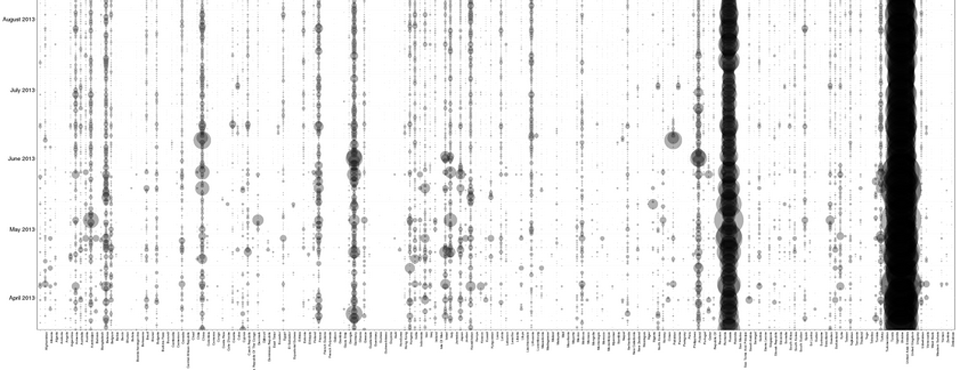GKG Thematic Timeline Visualizer

Dataset: Global Knowledge Graph
Description: Creates a unique gridded timeline showing intensity by day of each GKG theme - Y axis is day and X axis is each GKG theme, making correlations among themes instantly visible.
Components: PERL, R
Example: Timelines of Countries and of Themes
The GKG Thematic Timeline Visualizer allows you to create a unique gridded timeline visualization from the GDELT Global Knowledge Graph (GKG) to understand temporal patterns in the thematic undercurrents of your search. In this visualization the X axis represents each GKG theme, while the Y axis represents each day of the data (currently this only goes back to April 1, 2013 for the GKG). Thus, rows represent each day and columns represent a given GKG theme across days. At each grid cell a semi-transparent dot is displayed, sized based on the percentage of all GKG records from that date matching your search criteria that contained that theme (thus these timelines are normalized against GDELT's exponential growth over time). The compact nature of this visualization allows you to spot temporal patterns at the daily level, whereas with a traditional barchart or line graph timeline, the individual bars or line points would be too small with this many points to see anything. In addition, the unique gridded nature of this visualization allows you to rapidly spot weak temporal correlations among themes. For taxonomic themes, only the root theme is displayed.
No programming or technical skills are required to use this timeline visualization - you simply specify a set of person or organization names, locations, or Global Knowledge Graph Themes, along with an optional date range, and the system will automatically search the entire Global Knowledge Graph for all matching entries and compile the final timeline. Your results will be emailed to you when complete, usually within 10 minutes, depending on server load and the time it takes to perform the necessary calculations. All GDELT Global Knowledge Graph records are scanned for your search parameters and the average prevalance of matching records is averaged by day. Thus, selecting "Nigeria" as your search criteria will generate a timeline of what percentage of each day's coverage of Nigeria mentioned each GKG theme, as well as a .CSV file with the results for import to an external statistical package.